Quantum communication is a new interdisciplinary subject developed in the past two decades. It is a new research field combining quantum theory and information theory. The efficient and safe information transmission brought by it has attracted more and more people's attention, and it is based on the basic principles of quantum mechanics, and thus has become a research hotspot in quantum physics and information science in the world.
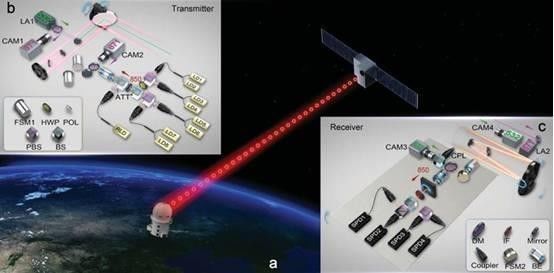
On August 16 last year, the world's first quantum science experimental satellite "Mozi" was launched. In less than a year, it completed the original two-year high-speed quantum key distribution, quantum entanglement distribution and ground. The three scientific goals of the star quantum teleportation experiment.
The research team of the University of Science and Technology of China, using the "Mozi" quantum science experimental satellite, successfully achieved quantum key distribution from satellite to the ground and quantum teleportation from the ground to the satellite for the first time in the world.

Quantum communication, also known as quantum teleportation, refers to a transmission process without a trace. Quantum communication is a communication method in which information is carried by a quantum state. It uses a quantum entanglement principle of elementary particles such as photons to implement a secure communication process. Quantum communication is a new way of communication. It transmits no longer classical information but quantum information carried by quantum states. It is the core element of future quantum communication networks.
According to common sense, the dissemination of information requires a carrier, and quantum communication is the transmission of information without a carrier. From a physics perspective, the process of invisible transmission can be imagined by first extracting all the information of the original and then transmitting the information to the receiving location. Based on the information, the recipient selects the basic unit that is identical to the original (eg: Atom), making a perfect replica of the original.
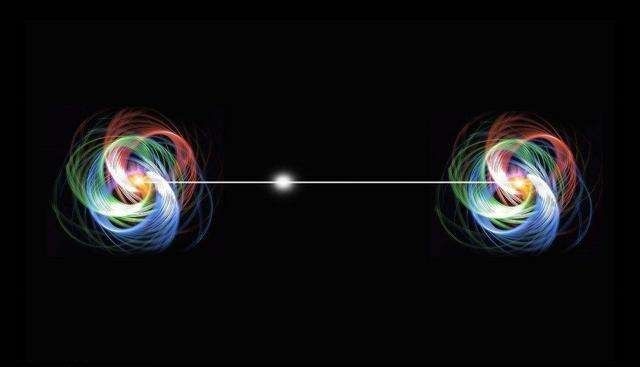
Quantum teleportation transmits quantum information, which is the most basic process of quantum communication. Based on this process, people put forward the idea of ​​realizing quantum Internet. Quantum Internet uses quantum channels to connect many quantum processors, which can simultaneously transfer and process quantum information. Compared with the classic Internet, the quantum Internet has security and confidentiality features, which can realize multi-end distributed computing and effectively reduce communication complexity and other advantages.
Quantum cryptography is an important part of quantum communication. Unlike traditional cryptosystems, quantum cryptography relies on physics as a key aspect of security models rather than mathematics. In essence, quantum cryptography is an unbreakable cryptosystem developed based on the application of individual photons and their inherent quantum properties, because the quantum state of the system cannot be determined without interfering with the system. At the same time, quantum cryptography is a relatively easy and convenient way to connect key values ​​in public key-value cryptography.
The fields involved in quantum communication mainly include: quantum cryptography communication, quantum remote transmission and quantum dense coding.
The origin and development of quantum communication
The earliest thought of using quantum physics for cryptography was the American scientist Wisner. He proposed in 1970 that he could use the single quantum state to make unforgeable "electronic banknotes." However, the realization of this idea requires long-term preservation of the single quantum state, which is not realistic and has not been accepted by people. However, his research has pioneered the quantum cryptography.
American scientist Bennett and Canadian scientist Brassard first proposed using quantum bits as information carriers in 1984. The two parties first generated and safely assigned quantum keys, and then used the assigned keys to "once" A dense way to achieve secure communication. This is the famous BB84 agreement.
In 1991, Ekert of the University of Oxford in the United Kingdom proposed a new quantum key distribution scheme. This scheme is achieved by quantum entangled states. Its security is judged by Bell's inequality.
In 1992, Bennett revised his proposed BB-84 scheme and proposed a scheme B92 protocol that uses only two non-orthogonal states to achieve efficiency but halved the efficiency. The non-cloning theorem guarantees the security of the B92 protocol. .
In 1993, the British Defense Research Department implemented the BB84-QKD solution using phase encoding in optical fiber, and the optical fiber transmission length reached 10 kilometers. By 1995, the transmission distance in the fiber reached 30 kilometers.
In 1993, six scientists, including American scientist Bennett, proposed a technique for transferring a quantum state of a particle to another particle using a pure quantum method, that is, a quantum teleportation technique. This method can overcome the influence of the quantum channel on the quantum state and guarantee the security of the quantum information.
In the Austrian Anton, Zelinger team, in 1997, the first quantum invisible transmission technology was realized experimentally in the laboratory. By 2004, the team had increased the distance of quantum teleportation to 600 meters.
In 2002, German and British research institutes successfully used lasers to transmit photon keys between two peaks at a distance of 23. 4km, confirming the possibility of transmitting quantum keys through near-Earth satellites.
In 2004, BNN established the world's first quantum cryptography communication network in Cambridge, Massachusetts, and put it into operation.
In 2004, the Pan Jianwei team of the University of Science and Technology of China took the lead in the international realization of the preparation of the five-particle entangled state, and successfully completed the quantum state stealth transmission using the five-photon entanglement source, realizing the real-time speech quantum secure communication for the first time. The idea of ​​establishing a quantum secure communication network in the city has become a reality. In the same year, Guo Guangcan's research team successfully realized the quantum key distribution of point-to-point 125km fiber.
In 2007, the Pan Jianwei team achieved the first optical fiber quantum communication experiment of more than 100 kilometers in the world.
In 2008, the 7-node secure communication demonstration verification network established by the European Union was successfully commissioned.
In 2009, Pan Jianwei team realized the active line switching technology based on optical switch, built the world's first freely expandable isotactic quantum communication network in Hefei, and increased the safe communication distance to 200 kilometers by using superconducting single photon detector. .
In 2011, at the "Eleventh Five-Year" major scientific and technological achievements exhibition held in China, there were two important research results that aroused people's interest and concern in quantum communication technology. They are "experimental realization of 16 km free space quantum teleportation" and "photon information network".
On August 9, 2012, Nature published the latest research results on the stealth transmission of quantum states by Chinese University of Science and Technology Pan Jianwei and Peng Chengzhi. They successfully realized the free-space quantum state teleportation of the 100-kilometer level in Qinghai Lake. Two-way entanglement distribution.
Basic theory of quantum communication
The concept of "quantum bits" is introduced in quantum information. In quantum information theory, the basic unit of quantum information is quantum bits. Physically, quantum bits are quantum states with properties of quantum states, so there are many features that are different from classical bits. There is currently no clear definition of qubits, and their descriptions are described in terms of specific physical characteristics.
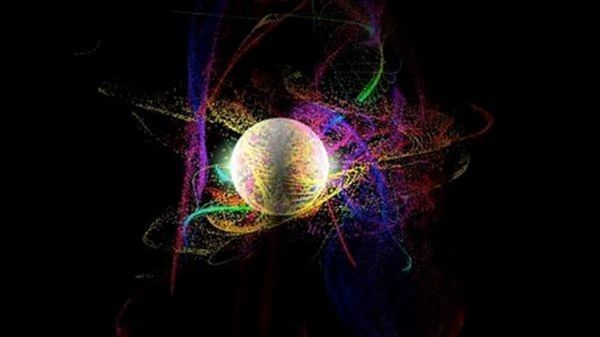
The existing classical information uses bits as the information unit. From a physical point of view, the bit is a two-state system, which can be prepared as one of two identifiable states, YES or NO, true or false, 0 or 1. The voltage between the plates of the capacitor can represent information bits, with a charge representing 1 and no charge representing 0.
A qubit is a superposition of two logic states. Classic bits can be seen as special cases of qubits (c0 = 0 or c1 =0).
The quantum state to represent information is the starting point of quantum information. All the problems of information must be processed by quantum mechanics theory. The evolution of information follows the Schrödinger equation. Information transmission is the transmission of quantum states in quantum channels. Information processing (calculation) is The unitary transformation of quantum states, information extraction is the quantum measurement of quantum systems.
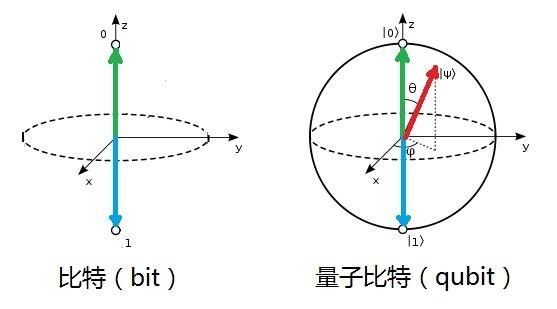
A qubit is a two-state quantum system, two linearly independent states, often referred to as: |0> and |1>. Based on these two independent states, Zhang is a two-dimensional complex vector space, that is, a two-dimensional Hilbert space. Its arbitrary state vector I> is a binary basic qubit with |0> and |1> as the base vector of the two-dimensional Hilbert space.
In experiments, any two-state quantum system can be used to prepare quantum bits. As a carrier of quantum states, the orthogonal polarization states of photons, the spins of electrons or nuclei, the energy levels of atoms or quantum dots, The spatial pattern of any quantum system, etc.
Once information is quantized, the characteristics of quantum mechanics become the physical basis of quantum information. The main ones are:
1. Quantum entanglement: N (greater than 1) qubits can be in a quantum entangled state, and the local states of the subsystems are not independent of each other. For a subsystem, the state of the other subsystem is obtained.
2. Quantum non-cloning: The linear properties of quantum mechanics prohibit the exact reproduction of arbitrary quantum states. The quantum non-cloning theorem and the principle of uncertainty constitute the physical basis of quantum cryptography.
3. Quantum superposition and coherence: The qubit can be in the superposition state of two eigenstates. In the operation of the qubit, the superposition amplitudes of the two states can interfere with each other. This is called quantum coherence.
The basic principle of quantum communication
All the problems of information are treated by the theory of quantum mechanics: information transmission is the transmission of quantum states in quantum channels, information processing is the unitary transformation of quantum states, and information extraction is the quantum measurement of quantum systems.
Quantum teleportation uses the quantum state as the information carrier to complete the transmission of large-capacity information through quantum state transmission. It is a kind of “complete†information transmission from the physical object, which can achieve complete confidentiality in principle. Quantum teleportation and dense coding are two typical methods in quantum communication. The former uses the classical auxiliary method to transmit the unknown quantum state, while the latter uses the quantum channel to transmit the information represented by the classical bits.
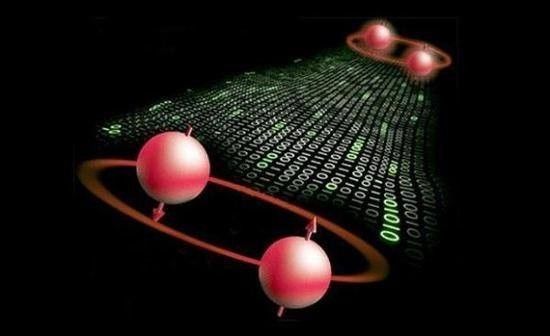
In science fiction movies, there are often scenes in which a mysterious character suddenly disappears somewhere, but then appears inexplicably in a different place. The term teleportation comes from this. Unfortunately, in classical communication, this method of implementing teleportation violates one of the fundamental principles of quantum mechanics—the uncertain relationship. So for a long time, this is just a scientific fantasy.
However, in addition to promoting the concepts of source and channel in classical information, quantum communication also introduces its unique quantum entanglement, creating an incredible miracle in the classical communication of quantum teleportation.
In 1993, six scientists, such as Bennett, proposed that the information of unknown quantum states be divided into two parts: classical information and quantum information, which are transmitted to the recipients by classical channels and quantum channels, respectively. The classic information is obtained by the sender taking some kind of measurement on the original, and the quantum information is the rest of the information that the sender did not extract in the measurement.

As shown in the figure, it is assumed that the sender Alice wants to transmit the unknown quantum state of the particle 1 to the receiver Bob. Before that, the two particles in the maximum entangled state proposed by Einstein, Podolsky, and Rosen are shared between the two. The right pair.
Alice performs a Bell-based joint measurement (BS) on particle 1 and her own EPR particle 2, and the measured result will appear in any of the four possible quantum states, with a probability of 1/4, corresponding to Alice's different measurements. As a result, Bob's particle 3 collapses to the corresponding quantum state. Therefore, when Alice advertises her detection results to Bob via the classical channel, he can select the appropriate 幺 transformation U particle 3 to prepare to the exact replicated state.
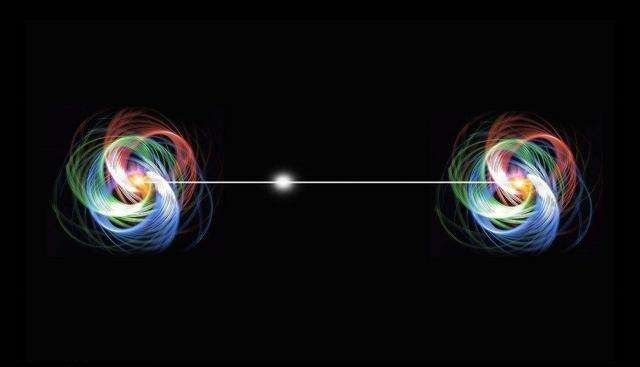
The characteristic of quantum teleportation is that only the quantum state is transmitted, but the particle 3 itself is not transmitted. After Alice measured, the initial state has been destroyed, so this process is not a quantum clone.
In recent years, people have turned their attention to transmitting an unknown entangled state, and some theoretical solutions have been proposed.
In the quantum teleportation, the transmission of classical information to quantum information is realized. So, can we use quantum channels to transmit classical information?
Suppose Alice and Bob share a pair of particles in an entangled state to establish a quantum channel. Alice chooses one of four possible unitary transformations to operate on its entangled particle A, which actually encodes two bits of classical information. After that, Alice sends the particle A to Bob. Bob can perform the Bell-based joint measurement on the two particles to confirm the transformation made by Alice, thus obtaining 2 bits of information, that is, by transmitting only one particle. It can successfully transmit 2 bits of classic information. This is called "intensive coding."
Composition of a quantum communication system
The basic components of a quantum communication system include quantum state generators, quantum channels, and quantum measuring devices.
The model includes quantum sources, encoders (quantum state generators), channels (quantum channels), decoders (quantum measuring devices), and quantum sinks.
Among them: quantum source is the message generator; quantum sink is the receiver of the message; quantum encoder is used to transform the message into quantum bit, quantum state is used as the carrier of the message to transmit the quantum information; quantum decoder is used to put the quantum information bit Convert into a message;
The channel includes two parts: a quantum transmission channel and a secondary channel: the quantum transmission channel is a channel for transmitting a quantum signal, and the auxiliary channel refers to an additional channel other than a transmission channel and a measurement channel, such as a classical channel, which is indicated by a broken line in the figure. Quantum channels can be used alone or in combination with classical channels to transmit quantum information and classical information; quantum noise is an equivalent description of the effects of the environment on quantum signals.
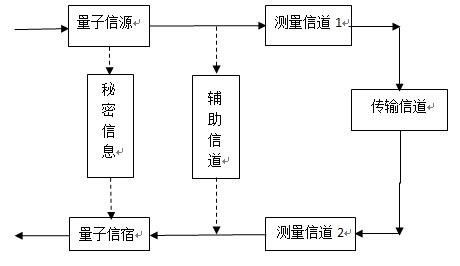
In quantum communication, the operands are qubit sequences, which can be in the superposition state of various orthogonal states, and can also be in the entangled state. In quantum communication technology based on entangled light sources, the carrier of information is entangled photons. Yes, quantum communication is achieved by correlating photon states of entangled photon pairs.
The basic principle of quantum key
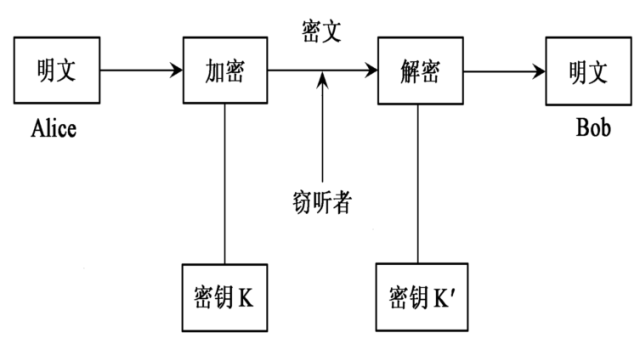
The secret communication system widely used in the network finance industry is a so-called RSA public key system. Its security is based on a large number factorization such as a one-way function that is not easy to calculate. The principle is shown in Figure 4-1. Although it is not strictly proved in mathematics that such a key cannot be deciphered, the existing classical computer can hardly complete such an operation.
The Short algorithm proves that this public key system can be easily deciphered by quantum computers. That is to say, once the quantum computing field has made a major breakthrough, its special performance will make the current public key system completely "insecure".

On the other hand, quantum communication is the only communication method recognized by the scientific community to achieve absolute security. It uses the uncertainty principle of quantum mechanics and the quantum non-cloning theorem to establish a key through a public channel. It is impossible to crack its password. The ultimate goal is to solve a series of fundamental problems in classic communications such as the absolute security of communications.
At present, the research of quantum cryptography has aroused people's wide interest, and has made important progress in both theory and experiment.
At present, there are mainly the following schemes for quantum cryptography:
1. A four-state scheme based on two conjugated groups, represented by the BB84 protocol [7].
2. Based on two non-orthogonal two-state schemes, such as the BB92 protocol.
3. The EPR particle pairing scheme based on quantum entanglement is called E91 protocol.
3. The key distribution scheme based on orthogonal state is based on the non-cloning theorem of orthogonal states.
In recent years, people have begun to seek a method to strictly prove the security of quantum key distribution (QKD). At first, several methods of proof are not satisfactory, and even quantum computers are needed. In 2000, Preskill proposed a simple scheme that combines the entanglement purification scheme with the quantum error correction code (CSS code) to rigorously prove the safety of the BB84 scheme.
The first demonstration experiment of quantum key distribution was done by Bennett et al. Subsequently, the Los Alamos National Laboratory of the United States, created a new record of the quantum cryptographic communication distance in the current fiber. Through advanced electronic means, they successfully transmitted quantum keys in a 48-km underground cable with the B92 solution. The QKD in free space has also made breakthroughs, and the transmission distance reached now is 115km.
In the above scheme, the quantum key is transmitted and established between two points, and thus is a point-to-point transmission system. To be practical, key distribution must be implemented in the network, enabling key-to-multipoint or any two-point key transfer.
Network key transmission has a variety of structures such as tree, ring, chain, etc. Here is a brief introduction of the tree structure network.
The tree structure network can be simply represented by the following diagram (Fig. 4-2), where S is the transmitting end, R1 is one of the receiving ends, and O is the fiber splitter. Although there are many receiving ends in the tree network, since the carriers in the quantum key are generally single-particle states, they cannot be shunted or cloned.
A single particle sent from the sender S can only be received by one of the receivers, which is equivalent to a peer-to-peer key distribution system between the sender S and the receiver. Therefore, after a series of data transmission is completed, each single particle state is randomly received by a receiving end, and the final effect is equivalent to establishing a point-to-point key transmission system between the sender S and the n receivers respectively. , respectively, a set of key sequences is established and assigned. The method of establishment can be any of the existing methods.
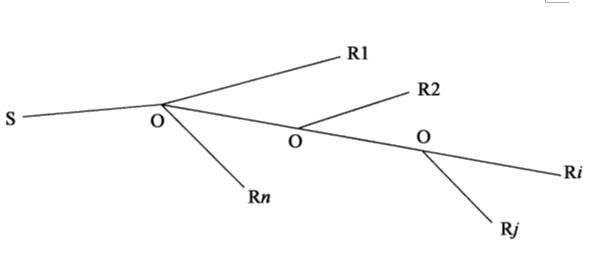
With regard to quantum secure communication, there are still many problems to be solved, including quantum secret sharing, network quantum cryptography, identity authentication, digital signature, and recently proposed quantum fingerprints. The superiority of these programs has been confirmed theoretically.
Quantum key communication system
The quantum key communication system includes three main parts: a quantum signal, a channel and a quantum sink. The channel includes a quantum transmission channel, a quantum measurement channel and an auxiliary channel. The key channel in the figure is the channel corresponding to the key finally obtained between the communicators, and is the ultimate goal of the quantum key distribution protocol, which is not a component of the quantum key distribution process, and is indicated by a broken line in the figure. The auxiliary channel refers to an additional channel other than the transmission channel and the measurement channel, such as a classic channel, which is indicated by a broken line in the figure.
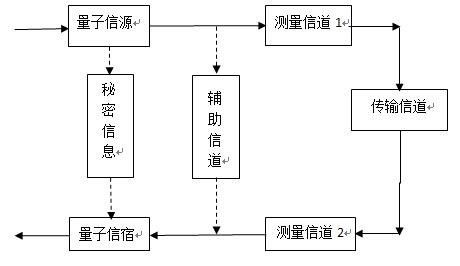
In the communication, the sink receives the first message, the information is not equal to the message, but is included in the message. Therefore, the characteristics of the information are often studied through the message. In general, the source is the source of the information, and the messages sent by different sources are different.
If the source outputs a quantum signal, this source is called a quantum source. Knowledge of a source usually requires a clear understanding of the mathematical description of the source, the structure and nature of the source, and the source coding.
The understanding and research on these issues in quantum sources is not yet deep, and many issues need further study. Referring to classical information theory, a quantum source can be defined as a quantum ensemble that outputs a set of specific quantum symbols (messages).
Obviously, once a quantum symbol set is specified, the quantum source has a definite mathematical structure, so that the quantum source can be described in a certain mathematical way. It should be pointed out that the quantum source is not equal to the quantum ensemble, because the quantum ensemble contains more physical properties, and the quantum source is only one aspect of the physical properties of the quantum ensemble.
The channel is an important part of the quantum key distribution protocol. The channel portion includes three parts of a quantum transmission channel, a measurement channel, and an auxiliary channel.
The so-called quantum transmission channel is the actual transmission route of quantum signals. The quantum transmission channel is similar to the classical channel. The channel properties depend on the input and output of the channel and the conditional probability describing the relationship between the input and the output. Therefore, the mathematical description of the quantum transmission channel is the same as the mathematical description of the classical transmission channel.
However, the quantum transmission channel is different from the classical transmission channel because the characteristics of the quantum transmission channel are constrained by quantum physics, that is, the channel is strongly constrained by the quantum physical properties of the transmitted signal, which is different from the classical physics in quantum physics. Caused.
The characteristics of quantum communication
Compared with traditional communication technologies, quantum communication has the following main features and advantages:
1. It has extremely high security and confidentiality. According to the quantum non-cloning theorem, once the quantum information is detected, it will produce irreversible changes. If the quantum information is stolen in the middle of transmission, the receiver must be able to find that the quantum communication has no electromagnetic radiation. The third party cannot perform wireless monitoring or detection;

2. The time-dependent high transmission speed is fast, the line delay of quantum communication is almost zero, the information efficiency of the quantum channel is several times higher than that of the classical channel quantum, and the process of quantum information transmission has no obstacles, and the transmission speed is fast;
3. Strong anti-interference performance. The information transmission in quantum communication does not pass through the traditional channel, and has nothing to do with the communication medium between the two communication parties. It is not affected by the space environment and has excellent anti-interference performance. Under the same conditions, a reliable communication station is obtained. The required signal-to-noise ratio is 30-40 dB lower than traditional communication means;
4, strong transmission capacity, quantum communication and media have nothing to do, transmission will not be blocked by any obstacles, quantum teleportation communication can also cross the atmosphere, can communicate in space, but also in the seabed communication, but also in medium such as fiber Medium communication.
Prospect of quantum communication technology
As a solution for information transmission security, quantum communication has become the focus of national research, and China is also a world leader in this field. Guosen Securities research report said that China is ready to commercialize quantum communication. Quantum communication may become another national "business card" in addition to high-speed rail and nuclear power.
At present, the basic theory and framework of quantum communication have been formed. Under the conditions of the development and breakthrough of quantum communication key technologies such as single photon, quantum detection and quantum storage, various theoretical systems are becoming more and more perfect, and quantum communication technology has gradually evolved from the scientific research stage. Entering the pilot application stage; the absolute confidentiality of quantum communication also determines its broad application prospects in the military, defense, finance and other fields. As the technology becomes more sophisticated and mature, in the future mass commercial market, quantum communication will have extreme Great application potential.
ZGAR Vape Device 5.0
ZGAR electronic cigarette uses high-tech R&D, food grade disposable pod device and high-quality raw material. All package designs are Original IP. Our designer team is from Hong Kong. We have very high requirements for product quality, flavors taste and packaging design. The E-liquid is imported, materials are food grade, and assembly plant is medical-grade dust-free workshops.
From production to packaging, the whole system of tracking, efficient and orderly process, achieving daily efficient output. We pay attention to the details of each process control. The first class dust-free production workshop has passed the GMP food and drug production standard certification, ensuring quality and safety. We choose the products with a traceability system, which can not only effectively track and trace all kinds of data, but also ensure good product quality.
We offer best price, high quality Vape Device, E-Cigarette Vape Pen, Disposable Device Vape,Vape Pen Atomizer, Electronic cigarette to all over the world.
Much Better Vaping Experience!


E-Cigarette Vape Pen,Disposable Device Vape,Vape Pen Atomizer,Latest Disposable E-Cigarette OEM vape pen,OEM electronic cigarette
ZGAR INTERNATIONAL(HK)CO., LIMITED , https://www.zgarette.com